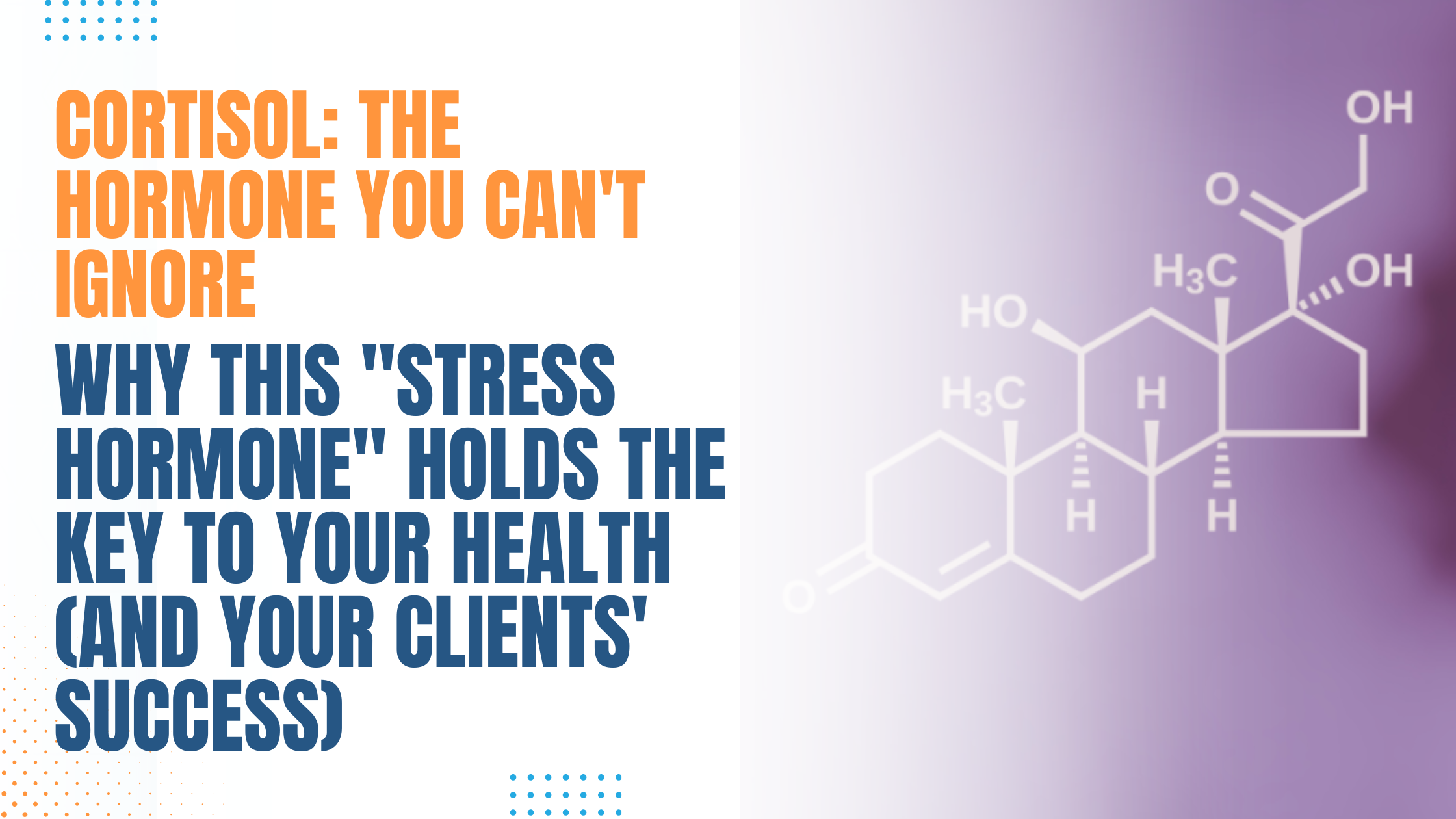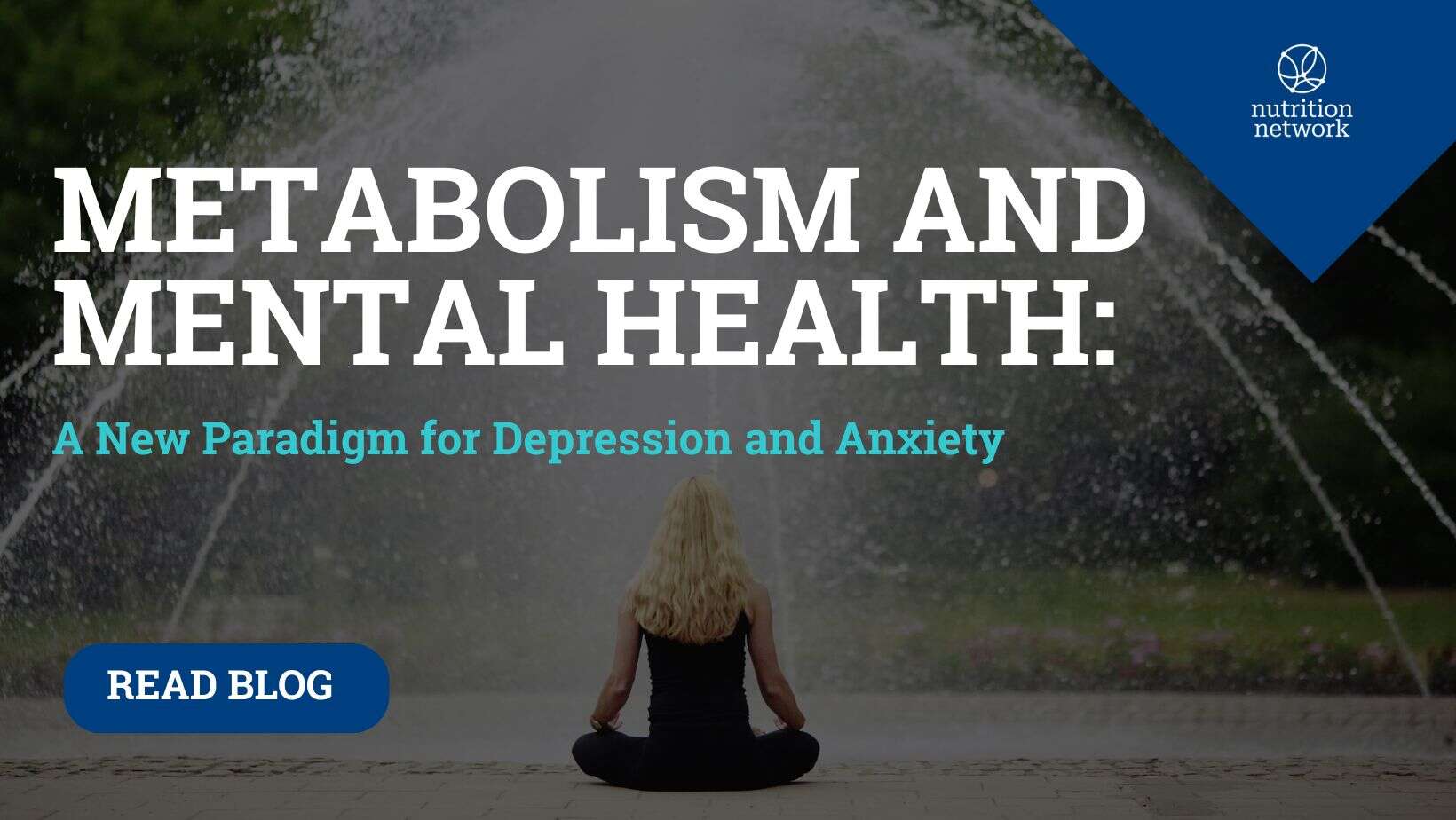What if the very hormone designed to help you survive is actually the reason you’re struggling to thrive?
My mother relentlessly saved and sacrificed so that she could enjoy her life in retirement. But two years into retirement, she was diagnosed with early onset Alzheimer’s.
Here’s what I’ve learned since becoming a Functional Diagnostic Nutrition Practitioner: she didn’t just “get” Alzheimer’s two years after retirement. It was building and building for years before that. She was making it worse with lifestyle choices: the over-exercising that women in their 40s and 50s often do, eating trans fats during the low-fat craze of the 80s and 90s.
Had I known what I know now, her outcome might have been different.
This is why I’m passionate about functional health. This is why thousands of practitioners are learning to identify and address the root causes of dysfunction before they become disease. If we can reach people in that gray space (when things are out of balance but before they become diagnosable conditions), we can change their trajectory. We can save lives.
As functional health practitioners, we see it every day: clients who’ve tried everything, followed every protocol, cleaned up their diet, and taken all the right supplements, yet they’re still stuck in that frustrating place of “I’m okay, but I’m not great.”
The missing piece? Understanding cortisol and its profound impact on every system in the body.
If you’ve ever wondered why some clients get amazing results while others plateau, or why you yourself might be experiencing symptoms that doctors dismiss as “normal aging,” this deep dive into cortisol will change everything.
What Is Wellness, Really?
Before we dive into cortisol, let’s get clear on what we’re actually working toward. At FDN, we don’t believe in “fine” or “okay.” We believe in abundant vitality.
Picture this as a spectrum:
The Right Side (The Medical Model): Symptoms → Sickness → Disease → Death
The Middle (Neutral Health): No symptoms, but no energy either. This is the “I’m fine, I guess” zone where most people live.
The Left Side (True Wellness): High energy, optimal function, metabolic fire, abundant vitality, joy for life.
Here’s the thing: neutral health equals a neutral life. When you’re operating from “I’m okay, I don’t have any complaints,” you’re not building empires, writing books, raising joyful kids, or showing up as your best self in relationships.
Good health, abundant vitality, is your birthright. It’s not just for the lucky few.

The Body’s Incredible Healing Power (And What’s Limiting It)
Your body is a self-healing machine. You know this because when you get a cut, it heals. When you break a bone, it mends. When you catch a cold, you recover.
But this healing ability isn’t infinite. If it were, we’d never age or die.
So what’s the difference between what your body can heal and what it can’t?
It’s a savings versus spending problem.
Think of your body as having a bank account called “Vital Reserve.” This is your innate intelligence: your body’s natural ability to function at 100% and fix imbalances before they become problems.
Where do you spend this precious currency? On your environment.
This has always been the case. Our paleolithic ancestors spent their Vital Reserve on not knowing if food would be available, dealing with harsh weather, avoiding predators, and navigating tribal conflicts.
Today? We spend it on mental-emotional stress, environmental toxins, and poor lifestyle habits that are constantly draining our account.
The main spender of Vital Reserve is stress.
The Modern Stress Problem: It’s Not What You Think
When most people think of stress, they picture this: work deadlines, traffic, relationship conflicts, financial pressure. And yes, these mental-emotional stressors are huge.
But there are two other categories most people completely miss:
Physical Stressors:
- Sitting too long
- Blue light exposure from screens
- Too much coffee
- Not exercising enough (or exercising too much)
- Needing wine to fall asleep
- Poor sleep quality
Environmental Stressors:
- Depleted soils
- EMF exposure
- Chemicals in food, water, and air
- Toxins our paleolithic ancestors never encountered
Plus, there’s the existential stress of modern life: What’s my purpose? How do I make my life meaningful when I’ll likely be forgotten in 100 years?
All of these are constantly withdrawing from your Vital Reserve account.

Meet Cortisol: Your Body’s “Energy on Credit” System
Cortisol is your primary stress hormone, and it’s actually designed to help you survive. When your environment throws stressors at you, cortisol says, “We need to put internal spending on hold and take all available resources to deal with this external threat.”
Cortisol breaks the body down for quick energy. We call this “catabolic.”
Why would your body have a mechanism for breaking itself down? Because sometimes you need energy RIGHT NOW. When your boss says, “This project is actually due in 30 minutes,” you can’t drive to the store, buy food, cook it, eat it, digest it, and then produce energy. You need quick fuel immediately.
So cortisol reaches for easy-to-break-down tissues like cartilage, tendons, connective tissue, and muscle, converting them to blood sugar.
Here’s the kicker: Cortisol is also a natural painkiller and anti-inflammatory. It masks the damage it’s doing, which is why it makes you feel amazing in the moment: clear thinking, quick reactions, pain-free movement.
Think of cortisol as your body’s credit card. You’re borrowing energy now and promising to pay it back later through rest, recovery, and healing.
When “Energy on Credit” Becomes a Problem
Throughout history, humans dealt with stress that was intense but occasional and short-lived. A wild animal attack, a natural disaster, a tribal conflict: these were serious but temporary.
Take a moment to think about this: Does this describe the stress in your life?
For most of us, stress is intense, constant, and never-ending. We wake up stressed, work stressed, drive home stressed, and lie in bed stressed about tomorrow’s stress.
This creates what we call “catabolic debt”: you’re constantly running up charges on your cortisol credit card without ever paying it back.
Chronic stress is not within our biological design.
Consider this: Anthropological studies show paleolithic humans worked only 15-20 hours per week. How many of you work only 15-20 hours per week? (And remember, “work” includes housework, childcare, and all the other responsibilities that don’t stop when you leave the office.)
They lived in close communities with cooperative resource sharing and had each other’s backs. Think about your own life: Do you know your neighbors? If you do, would they really have your back if things got serious?
Most of us are duplicating resources instead of sharing them. We’re all figuring out our own childcare, making our own meals, maintaining our own everything. There’s no interdependence, no shared load.
The cost of modern life is enormous:
- 70-80% of doctor visits are for stress-related illnesses
- People with high anxiety are 4-5 times more likely to die from heart attack or stroke
- Stress contributes to 50% of all illnesses

The Stress Response Curve: Your Roadmap to Understanding Where You Are
This is where it gets really interesting. Understanding this curve will change how you see your health (and your clients’ health) forever.
We all start in the green zone: Homeostasis. When you experience occasional stressors, cortisol and adrenaline spike, you handle the situation, then return to baseline to rest and repair.
But when stress becomes chronic, you move into the orange zone: Acute Stress. You’re constantly producing cortisol and adrenaline, never returning to homeostasis.
Here’s the thing: on your way up this curve, you feel AMAZING. Remember when you could pull all-nighters and still ace exams? When you could eat junk food without consequences? When you had laser focus for 12-16 hours straight?
That’s the acute phase. You’re running on cortisol, and it feels like superpowers.
Then you hit Peak Production. Your body says, “We’ve put way too much on the cortisol credit card. We have to cut back.”
Now you fall into the Compensatory Phase. Your cortisol numbers might look normal to a doctor, but the distribution is all wrong. Maybe you have too much in the morning and crash by afternoon, or you spike at night and can’t sleep.
Plus, you have a relativity problem. You’re used to feeling like Superman from the acute phase, so normal cortisol levels feel terrible by comparison.
Continue down this path, and you reach the Exhaustive Phase. Like a phone on low battery mode, everything still works but at 30% capacity and not for long. You’re devoting everything to just getting through the day.
The Hidden Cost: What Happens to Your Body’s Core Systems
At FDN, we focus on six foundational systems that chronic stress systematically shuts down. We call them the H-I-D-D-E-N systems, and understanding what happens to each one under chronic stress is crucial for practitioners:
H – Hormones DHEA is your anabolic hormone: the one responsible for building you back up after cortisol breaks you down. This is how you pay off your cortisol credit card. But when stress is constant, DHEA steps back and says, “I’ll come back when it’s safe to focus internally, but right now we need to keep spending on the environment.” DHEA becomes chronically low, which means your healing potential becomes chronically low.
Then sex hormones get the message: “We don’t have enough resources to fund fertility right now.” Sex hormones plummet, taking motivation and joy for life with them. This is when you get to that neutral state where you’re thinking, “I have dreams I want to pursue, but it’s just too much effort. I’ll just watch Netflix instead.”
I – Immune Your immune system is expensive to run. Under chronic stress, it says, “I cost a ton of money, so I’m going to operate at 30% capacity and not for very long.” Now you’re getting sick often, it takes forever to heal, you can’t shake that cough, and if anyone around you is sick, you know you’re going down.
D – Digestion Digestion costs a lot of energy to function properly. When you’re spending everything on stress, digestion goes into low-power mode. Now you’re only digesting at 30% capacity. Even if you’re eating the cleanest diet in the world, you can’t use it. You’re not getting the building blocks to repair or the nutrients your body needs to power metabolic functions at full capacity.
D – Detoxification Detoxification is another huge system that’s expensive to run. When your body’s bank account is overdrawn from cortisol debt, detox says, “I don’t have enough money to find these toxins, bind them up, and effectively remove them. So I’ll put them in storage instead.” Your body shoves toxins into fat cells, brain tissue, and bones, creating a toxic backlog that makes you feel slow, gives you acne, throws off digestion, and impairs hormone production.
E – Energy Production Your mitochondria can’t function optimally when all resources are diverted to stress response. This leads to that “tired but wired” feeling where you’re exhausted but can’t actually rest.
N – Nervous System Sleep, mood, and cognitive function all suffer. This is where we see the brain fog, insomnia, anxiety, and depression that so many people struggle with.
The fundamental principle of FDN: These systems don’t operate in isolation. You can’t just say, “Oh, you have classic hormone symptoms, so let’s run a hormone test.” You miss immunity, digestion, detoxification: all the other systems contributing to what we call “Metabolic Chaos.”
This is why the “take this supplement for that symptom” approach rarely works long-term. You’re not dealing with isolated problems: you’re dealing with systemic dysfunction where multiple systems are compromised simultaneously.

Real-Life Case Studies: The Stress Curve in Action
Let’s look at three real clients to see how this plays out. As FDN practitioners, we use what we call “clinical correlation,” which means we never look at lab numbers in isolation. We always consider how someone feels alongside their test results.
Case Study 1: Adam – The Acute Phase Crash
Profile: 35-year-old male, broker at a mid-size investment firm, former athlete still crushing CrossFit workouts
Symptoms: Weight gain, trouble concentrating, loss of muscle mass despite rigorous workouts, headaches
Doctor’s Assessment: “Your results are unremarkable. This is normal aging.”
Lab Results:
- Cortisol sum: 9 (acute phase)
- Four-point pattern: Way too high in morning, drops low at noon, crashes severely in afternoon, bounces back up at night
- DHEA: 2 (low end of normal range)
- Clinical correlation: Catabolic debt despite “normal” DHEA
The Reality: How do we know Adam isn’t on the left side of the stress curve going up into acute phase? His symptoms tell us everything. If he were on the way up, he’d feel amazing and wouldn’t be in our office. Instead, he’s on the right side coming down from peak production.
His cortisol pattern explains everything: sky-high morning cortisol makes him feel wired and anxious, the afternoon crash leaves him unable to concentrate (not ideal for an investment broker), and the nighttime spike disrupts his sleep.
Even though his DHEA looks “normal,” when we compare it to his cortisol level of 9, he’s clearly catabolic dominant. He’s breaking down faster than he’s building up, which explains why his intense CrossFit sessions aren’t building muscle: they’re just adding more stress to an already overloaded system.
Case Study 2: Caitlyn – The Compensatory Struggle
Profile: 48-year-old court stenographer, recently divorced
Symptoms: Insomnia, fatigue, joint pain
Doctor’s Assessment: “Your results are fine. Everything’s in normal range.”
Lab Results:
- Cortisol sum: Compensatory phase (appears “normal” to doctors)
- Four-point pattern: Way too low in morning, slightly higher at noon, drops severely in afternoon, spikes at night
- DHEA: Low
- Clinical correlation: Cortisol dominant, catabolic debt
The Reality: Caitlyn’s cortisol sum looks normal, but the distribution is completely dysfunctional. She can barely drag herself out of bed in the morning, crashes hard in the afternoon (imagine trying to accurately record legal proceedings when your cortisol is plummeting), and lies awake at night because her cortisol spikes just when it should be lowest.
She also has a relativity problem. When she was in the acute phase, she felt like Superman. Now that she’s in compensatory with “normal” cortisol levels, she feels terrible by comparison. Her DHEA is low, confirming she’s still in catabolic debt despite the lower cortisol numbers.
Case Study 3: Maggie – The Exhaustive Phase Crisis
Profile: 43-year-old chef at a popular five-star restaurant, diagnosed with hypothyroid
Symptoms: Weight gain in hips and belly, trouble keeping up at work, depression, irregular menstrual cycle
Lifestyle: Working 60+ hours per week, consistently sleeping only 5 hours per night
Medical Status: Seeing a counselor, considering antidepressant medication
Lab Results:
- Cortisol sum: 3.1 (exhaustive phase)
- Four-point pattern: Way too low in morning, drops low at noon, slight bounce in afternoon, drops again at night
- DHEA: Very low
- Clinical correlation: Still catabolic dominant despite low cortisol
The Reality: Maggie’s body is operating like a phone on low battery mode: everything still works, but at 30% capacity and not for long. Her thyroid has downregulated because there’s literally not enough energy in the system to maintain normal function.
The depression isn’t just psychological: it’s physiological. Her body can’t afford to fund optimal brain function. Even though her cortisol is very low and her DHEA is very low, she’s still cortisol dominant and in catabolic debt.
This is why understanding the stress curve is so crucial. Three people, three different phases, three different approaches needed.

The Path Forward: Why Understanding Cortisol Changes Everything
Here’s why this matters for you as a health practitioner:
1. It explains why some clients plateau. If you’re not addressing the stress component, you’ll hit a ceiling on healing no matter how perfect the diet or supplement protocol.
2. It validates your clients’ experiences. When someone says, “I used to be able to handle so much more,” or “I don’t feel like myself anymore,” you now understand the physiology behind it.
3. It gives you a roadmap for intervention. Different phases require different approaches. Someone in the acute phase needs different support than someone in the exhaustive phase.
4. It highlights the importance of comprehensive testing. A single cortisol measurement tells you almost nothing. You need the full pattern plus clinical correlation.
The FDN Approach: Test, Don’t Guess
At FDN, we don’t just talk about stress: we measure it. We use what we call “clinical correlation,” which means we never look at lab numbers in isolation. We always consider how someone feels alongside their test results.
We look at:
- Four-point cortisol patterns throughout the day (not just a single measurement)
- DHEA levels and the cortisol-to-DHEA ratio
- How stress is affecting all the H-I-D-D-E-N systems
- The complete picture of metabolic chaos
- Progress tracking with tools like the Metabolic Chaos Scorecard
Then we address it systematically through our DRESS protocol:
D – Diet: Personalized nutrition based on lab findings, not generic “healthy eating” advice
R – Rest: Sleep optimization and recovery strategies tailored to your stress phase
E – Exercise: Right-sized movement for your current capacity (over-exercise is just as harmful as under-exercise)
S – Stress Reduction: Targeted techniques for your specific stressors: mental/emotional, physical, environmental, and lifestyle factors
S – Supplementation: Targeted support based on actual lab results, not guesswork
This isn’t about generic protocols. It’s about understanding exactly where someone is on the stress curve and what their body needs to heal.
Key Takeaways for Health Practitioners
Cortisol isn’t the enemy. A lot of people talk about cortisol as if it’s the villain—commercials make it sound like cortisol just makes you “old and fat.” That’s not what cortisol does. Cortisol is a vital hormone for navigating stress. The problem is chronic stress disrupting its natural rhythm.
Understanding the stress curve is diagnostic gold. It explains why clients feel the way they do and gives you a framework for intervention. Different phases require different approaches.
Clinical correlation is everything. You can’t just look at lab numbers in isolation. A cortisol sum of 5 might be “normal” to a doctor, but if your client feels terrible and the distribution is dysregulated, that tells you the real story.
You can’t ignore stress and expect lasting results. No matter how perfect your diet protocol or how targeted your supplements, chronic stress will cap healing potential. There’s a ceiling you’ll never break through if you don’t address the stress component.
The body’s systems are interconnected. You can’t just “fix hormones” without addressing how stress is affecting immunity, digestion, detoxification, and all the other H-I-D-D-E-N systems. This is why comprehensive testing and systematic protocols are crucial.
Metabolic Chaos requires a systematic approach. When multiple systems are compromised simultaneously, you need a framework like DRESS that addresses all aspects of healing, not just isolated symptoms.
Your Next Steps
If you’re ready to master functional lab testing and learn how to identify and address cortisol dysregulation in your practice, FDN provides the training, community, and ongoing support you need.
Because here’s the truth: your clients deserve more than “fine.” They deserve abundant vitality. And you deserve the confidence that comes from knowing exactly how to help them achieve it.
When you understand cortisol (really understand it), you hold the key to unlocking transformation for every client who walks through your door.
Ready to become the practitioner who always knows what to do next?
The answer lies in data-driven functional health. The answer lies in understanding that robust health isn’t just about the absence of symptoms: it’s about the presence of vitality.
And it starts with the hormone you can’t ignore: cortisol.
Want to learn more about becoming a Functional Diagnostic Nutrition Practitioner?
Discover how our comprehensive training program gives you the tools to master cortisol testing, interpretation, and protocols that get results. Because when you know how to test, you never have to guess. View an indepth case study here.










